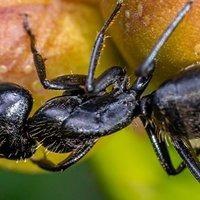Everyone in Worcester knows the big pest problems we have here in New England: cockroaches, rodents, moths, termites, and the like. However, a lesser-known common pest is just as prevalent in our region as its more famous counterparts, and it can cause just as much damage. We’re talking, of course, about carpenter ants.
These large, dark-brown or black ants are similar to termites in that they’re evolved to live near and inside of wood. Carpenter ant species live in moist, rotting, or hollowed-out wood, usually in forests, but frequently inside your house. Unlike termites, carpenter ants don’t actually eat wood; instead, they eat insect meat, “honeydew” (the nectar produced by aphids), sugary liquids like honey, and whatever else they can forage.
Even though they don’t eat wood, carpenter ant colonies can still cause significant damage if left untreated. These ants prefer to nest in wood that is already moistened or decayed, and they hasten this wood’s destruction by hollowing out tunnels and chambers in which to store food, raise larvae, live, eat, and work. An untreated carpenter ant nest will often spread out and develop satellite nests, further eroding the wood of your home and ultimately leading to significant structural damage.
Signs Of Infestation
- Ant Activity – One major sign you could have a carpenter ant problem is if you actually see them. These ants don’t hide in their nests; they often travel significant distances to forage for food. The mere presence of workers doesn’t necessarily mean you’ve got an infestation, but it definitely means you should start looking for other signs.
- Wood Shavings – Like termites, carpenter ants bore tunnels through their nests both to open passageways for travel and to create exits that they use to push unwanted material out of their homes (kickout holes). If you see frass (insect-made sawdust) underneath kickout holes, it could be a sign you have carpenter ants. Since carpenter ants don’t actually eat wood, they just chew it up and push it out of their nests, you can expect a pretty significant amount of frass around the kickout holes.
- Winged Ants – Flying ants may start to appear both inside and outside of your house. These winged ants are reproductive males and females sent out from a mature colony with the express purpose of founding satellite nests. The presence of these ants means you’ve had an infestation for a while, and significant damage to your property may already have occurred.
- Noisy Walls – Since these ants spend a lot of time on woodwork, you may actually hear the sounds of their carpentry activity. It will sound like soft rustling or scratching emanating from inside your walls.
- Damaged Wood – A severe and prolonged infestation of carpenter ants will eventually lead to serious wood damage, such as weakened or warped door frames and support beams. These could lead to windows and doors sticking or no longer shutting, bucked walls, sagging ceilings, etc. If you see this kind of damage, it’s likely you’ve had an infestation for years.
Tips For Prevention
Carpenter ants usually access your home through cracks and holes in its walls/foundation, so there are a few ways to prevent infestations:
- Make sure leaks, plumbing issues, and other moisture problems are taken care of to avoid having moist wood that attracts ants.
- Keep stored wood, like lumber or firewood, away from your exterior walls and elevated off the ground to prevent outdoor nests from morphing into indoor nests.
- Ensure there are no branches or limbs touching your house.
- Make sure cracks and holes in your home’s foundation, walls, and frames around windows and doorways are well-sealed.
Unfortunately, even the most stringent measures don’t always prevent infestation. Even worse, carpenter ants are sneaky little buggers, and they can often establish and grow a colony for a long time without you noticing. If that happens, you’re going to need expert help.
Here at Big Blue Bug Solutions, we’ve got more than 80 years of experience in the pest control industry, meaning there’s no carpenter ant problem we can’t handle. Our residential pest programs protect against a wide variety of household pests, including ants, by both eliminating current infestations and preventing future ones. So give us a call at (888) 411-5699 or visit our scheduling page to arrange your service today!

